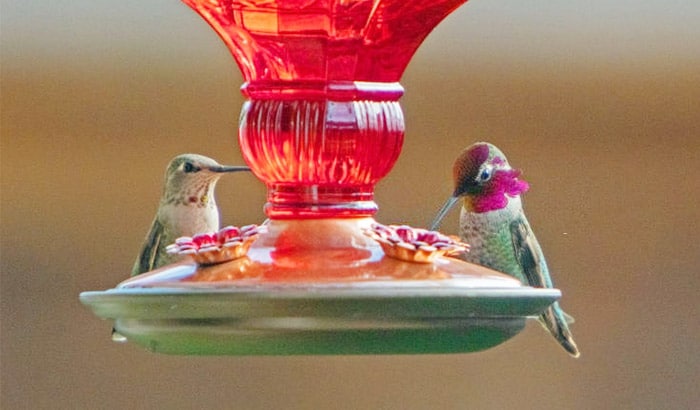There are over 330 species of hummingbirds worldwide, and telling them apart is not always a breeze. Even just identifying the differences between the male and the female of the same species can be challenging. In this male vs female hummingbirds blog, we will examine the differences between the two genders. Those differences lie in their appearance, size, and behavior.
I put their differences on a table so you can better compare them.
| Male Hummingbird | Female Hummingbird | |
| Appearance | Brightly colorful
Has iridescent gorgets or throats |
Dull in color
Plain-looking throats |
| Size | Smaller than females | Larger than males |
| Behavior | More aggressive
Dances and makes noise to attract females Migrates to breeding grounds earlier |
Builds nest alone
Chases away males from the nest |
Contents
Male vs Female Hummingbirds Differences
Because the differences in male and female hummingbirds are in their appearance, size, and behavior, those will be the categories we will examine.
Appearance
In the animal kingdom, the males are often the more extravagant in appearance; the male lion has the mane, the male elephant has the trunk, etc. You can see this trend more pronouncedly among birds. The male peacock, for example, has the more colorful tail feathers. The same is true of the hummingbirds.
Male hummingbirds have more colorful feathers than their female counterparts. Male and female hummingbirds look so different as the males will always have very bright feathers while the females look duller in color.
Aside from the general color, male hummingbirds have a distinct look around their throats, known as their gorget in the scientific avian world. Their throats are shimmery and iridescent, which means that the color seems to change depending on the angle that you look. Female hummingbirds, on the other hand, have very plain throats.
The gorget of male hummingbirds refract, or bend, light. The color can be orange, red, purple, blue, or pink. The male can also make their gorget look black to avoid getting the attention of predators. If you see any of these colors on a hummingbird’s throat, it is a mature male hummingbird. Females, on the other hand, often are colored brown or dull green.
Let’s look at one example. The ruby-throated hummingbird is one of the most common hummingbird species in North America. The species got its name because of the distinct color of the male’s throat; the males have a ruby-colored throat while the females have white throats. In different lightings, the male throat can appear red, pink, and even purple.
The brightness of their color and the iridescence of their gorgets allow male hummingbirds to attract females and display their dominance to other males. In fact, young and immature male hummingbirds look like females because their colors are yet underdeveloped, so they look dull as the females do.
Size
If immature and young male hummingbirds look like females in color, how can you tell them apart from the females? Another way to determine the sex of a hummingbird is its size. However, the size of a hummingbird is hard to tell unless you have a knack for determining dimensions without a measuring tool. Still, it’s worth knowing the size distinction of male and female hummingbirds if you want to be a practical avian enthusiast.
Female hummingbirds are larger than males of the same age and species. The weight of females ranges from 2.4 to 4.5 grams while males go from 2.4 to 3.6 grams only.
Let’s look at the ruby-throated hummingbird for reference again. The female ruby-throated hummingbird averages 3.8 grams in weight while the male averages 3.4 grams. Males are often only 2.8 inches in length, and females are 3.5 inches.
The difference in size is an evolutionary trait developed due to their different breeding roles. Because the females have to lay eggs, they need to have bigger bodies to do so. Additionally, females sit on top of their eggs; their bodies need to be big enough to cover their eggs and provide warmth.
Behavior
Male vs female hummingbirds in terms of behavior is another easy way to tell the sex of hummingbirds. Male hummingbirds are more aggressive. They rely on aggression to attract females and defend their territory (they are incredibly territorial). Males produce scratching chirps to either attract females or to argue with other male hummingbirds.
Another behavioral difference between the two genders is that male hummingbirds migrate first before females. They will fly to the breeding ground earlier to establish their territory before the females arrive.
In terms of breeding, males are a lot more proactive than females. The males are noisier and move a lot more. Once the male finds a female to mate with, he will dance. After the mating process, all the action will shift towards the females. The female singlehandedly takes care of her offspring. She builds the nest and chases away any male who ventures near her nest because the brightly colored male will attract predators.
Conclusion
Due to their breeding roles, you can find many differences between male and female hummingbirds. Here’s the last summary of male vs female hummingbirds.



Thanks for you article, very informative.